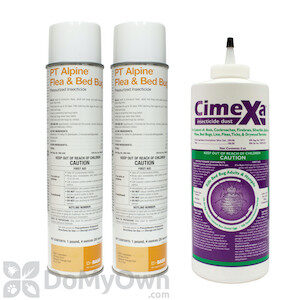Do I Need to Replace My Carpet to Get Rid of Fleas?
Fleas are a common problem for many pet owners. Those pesky little critters love to live in your carpet, but they can be difficult to get rid of! In addition to causing itchy discomfort to humans and pets, flea bites can cause an allergic reaction, and some flea species carry diseases such as plague, murine typhus, or fleaborne parasites. To avoid carpet infestations and keep your family and fur babies safe, it’s best to take preventative measures or take action at the first sign of fleas.
It can be challenging to get rid of fleas once they’ve taken up residence in your carpet. So how do you get rid of fleas in the carpet? Should you replace your entire carpet? If you treat your existing carpet with an effective treatment option, you should start seeing results. However, it’s important to keep in mind that fleas can spread easily to couches, furniture, and other things your pet might interact with. If you have a widespread infestation, it may be necessary to replace the carpet and treat your entire home.
To ensure all fleas have been eradicated from your home and property, make sure to clean everything thoroughly and vacuum often so as not to bring any inside again. Additionally, speak with your veterinarian about starting your pets on preventative treatment for fleas that will kill adult fleas and prevent further infestations by killing flea eggs and larvae.
It’s best to take action sooner than later before they set up camp and settle in for the long term. Here’s some advice on how to identify fleas in your carpet, methods for removing them, and ways to keep them out of your home for good.
How to Spot Signs of Flea Infestation in Your Carpet
There are several signs you should look for if you believe your carpet may be infested with fleas.
Look for Fleas, Flea Dirt, and Flea Eggs
Fleas are tiny, fast-moving insects that can be difficult to see in carpets, upholstery, or other places where pets spend time. A good way to test for fleas in your carpet is to do the “white sock test.” Put on a pair of tall white socks and walk around your home, shuffling your feet on the carpeted areas. If you see black specks jumping around your carpet or onto your socks, they are probably fleas!
Flea dirt is another telltale sign of fleas. This flea dirt is fecal material and often looks like little dark specks on your carpet. If you notice a lot of flea dirt, this is a good indication that there are fleas in your carpet.
Another obvious sign of fleas is flea eggs. A female flea can lay around 40-50 eggs per day! These small, oval-shaped spots of light brown or yellow are usually in the same areas as flea dirt. Look for them in the fibers of your carpeting with a magnifying glass. Finding flea eggs is a good sign that you may have an established infestation.
Identify Flea Bites on Humans
Fleas often bite humans, which can be another indicative sign of a flea problem in your home. These bites look like small itchy, red bumps and typically appear in clusters close to the ankles, feet, and lower leg when walking around flea-infested carpets. Flea bites can irritate the surrounding skin, causing red halos to form around each bite. In some cases, the saliva from flea bites can even cause an allergic reaction in humans.

Watch Your Pets for Signs of Fleas
Fleas will often live on and feed off of your pet, laying eggs in their fur and leaving flea dirt behind. Use a fine-tooth flea comb to closely check your pet’s fur for fleas and examine the skin for any signs of irritation.
The most noticeable sign that your pet may have fleas is scratching excessively or rubbing against furniture, a carpeted area, or the floor.
Because fleas are known to cause intense itching, excessive scratching can even lead to patches of hair loss on your pet. If you notice your pet scratching a lot or see patches of bald skin with raised red bumps, it may be worth examining them for flea bites.
Carpet Cleaning Methods to Kill Fleas
Once you’ve identified fleas in your carpet, it’s important to act fast! Thoroughly cleaning and treating your carpet is the first step to removing fleas from your home, preventing severe infestations, and saving yourself the hassle of replacing the entire carpet.
- Vacuuming
- Steam Cleaning
- Insecticide Treatments
- Natural Remedies
Vacuuming
Regular and thorough vacuuming with an upholstery attachment will remove all traces of dust and dirt particles which can act as a breeding ground for fleas. Work in small sections, ensuring you pass over every inch of your carpet and paying particular attention to the areas where your pets spend the most time. If you have a vacuum with disposable bags, close the bag tightly and dispose of it in a trashcan outside of your home. Repeat this method every 1-2 days.
Steam Cleaning
For more severe infestations, steam cleaning can be a highly effective tool. The combination of high heat and detergent kills adult and larval fleas on contact. For best results, use a steam cleaner with an attachment designed for deep cleaning carpets.
Insecticide Treatments
Insecticides are a great way to kill adult fleas, larvae, and eggs. These treatments can be applied as an aerosol spray, liquid treatment, or powder that will spread over your carpet. Make sure you follow all instructions on the package for use before applying any insecticide product to your carpets.
Natural Remedies
You can also use natural remedies to get rid of fleas. One option is a baking soda and apple cider vinegar solution. Spray the solution directly onto your carpet, leave it to dry for a few hours, then vacuum up the excess liquid. The acetic acid in this treatment will kill adult fleas by dehydrating and breaking down their exoskeletons. Be sure to avoid using this treatment on colored carpets or furniture, as the vinegar can permanently discolor these items if left too long.
If you find fleas in your carpet, use one or more of the many methods listed above to kill these pesky bugs before they make themselves comfortable in your home!
When Carpet Removal May Be Necessary for Fleas
If you have a severe flea infestation in your carpet that is resistant to any of the above methods, replacing the entire carpet may be necessary. This is especially true if there’s a pet in your home that has recurring cases of fleas. Removing the carpet as soon as possible and replacing it with another flooring material will make it much easier to maintain and prevent the infestation from returning.
Another instance where carpet removal may be necessary is with pre-existing allergies or asthma to dust mites, animal dander, and other allergens commonly found in carpets. If even the best cleaning or flea treatment methods aren’t enough to remove the fleas and particles from your carpet, it may be time to consider a replacement.
There are a lot of different ways you can set out to kill flea infestations in your carpeting—it’s up to you which method will work best! Keep in mind that even if one method seems to work better than another, it’s important to stay consistent. Continue using that method until the flea infestation is completely gone and you are sure no more eggs have been laid. This could make the difference between saving your carpet or having to remove it completely.
Related Questions
Is it safe for pets to be around steam and other treatments for rug infestations? For most of the above cleaning methods, yes. As long as you take the appropriate precautions to keep pets out of the area and follow all instructions when using chemicals or insecticides, it should generally be safe for your pets after the treatment is completed.
Do you need professional help to get rid of fleas in your carpet? Although many at-home flea treatments are effective with consistency, it can be a frustrating process that takes weeks or months of work to fully eradicate the infestation. Getting your carpet treated by a local professional can save you time, money, and stress in the long run!

